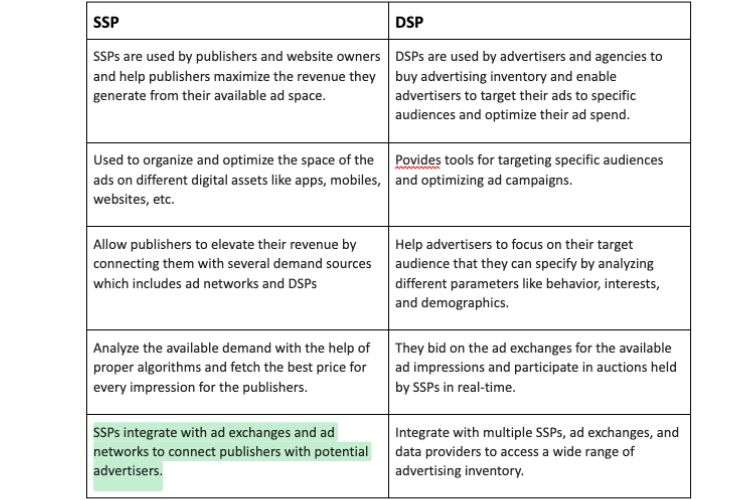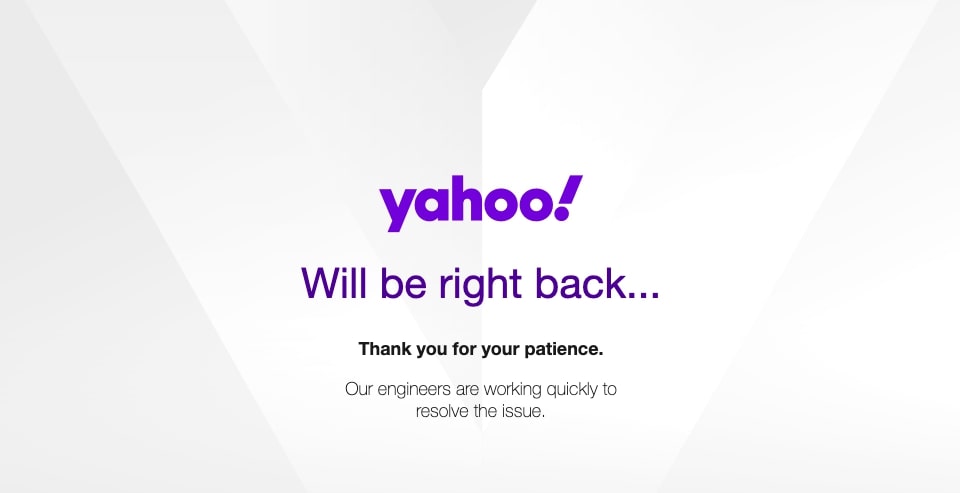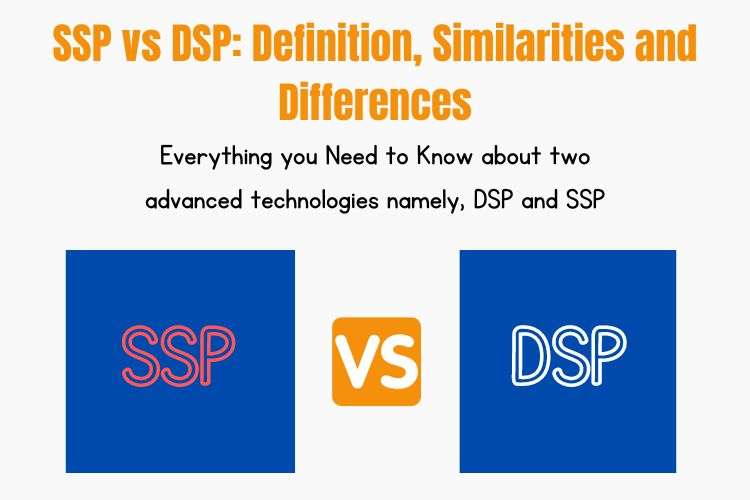SSP vs DSP: Definition, Similarities and Differences
According to WebFx, ads help boost brand awareness by 80%. The online advertising marketplace is ruled by two advanced technologies namely, DSP and SSP. But no one knows their exact functions and how they are helpful to yield the desired results. So, in this comprehensive guide, we shall uncover all the basics about these terms, their similarities, and their best practices in detail. By highlighting the differences between SSP vs DSP, you will learn about their distinct features properly. So, without any further ado, let’s get started!
What is DSP and its Example?
DSP stands for Demand Side Platform. It is useful for advertisers to get instant access to the digital inventory for hassle-free management of multiple ads. There are a plethora of options for tracking and optimizing ads, broadening the target area and audience as well as performing real-time bidding. In short, the advertisers get full control over the impact of ads. These platforms contain everything you need to create excellent online campaigns. Examples: Facebook Ads Manager, Amazon Advertising Platform.
What is SSP and its Example?
SSP stands for Supply Side platform. It enables the publishers to manage their advertising space efficiently. The platform’s user-friendly interface allows multiple task handling in one place making the job of placing online ads quite easier for publishers. They can automate and optimize their space to showcase the ads to a selected target audience. In short, the publishers have full control over selling their advertising space. SSPs are considered to be the reliable ‘Auction Houses’ of the online advertising industry. Examples: Google Ad Manager, Pubmatic, OpenX.
Similarities between DSPs and SSPs
Both DSPs and SSPs work to achieve a common goal, maximizing the effectiveness of different advertising activities. DSPs connect advertisers to the right publishers and help them have complete control on ads and their impact. On the other hand, SSPs ensure that publishers sell ads at top-notch rates. Thus, both SSPs and DSPs utilize the best resources to help in the risk reduction for publishers underselling all their ad inventory.
SSP vs DSP: Differences
Check out the top differences between SSPs and DSPs shared below:

Purpose
SSPs are used by publishers and website owners to manage and optimize the sale of their advertising inventory to advertisers. They help publishers maximize the revenue they generate from their available ad space.
DSPs are used by advertisers and agencies to buy advertising inventory across various publishers and websites. They enable advertisers to target their ads to specific audiences and optimize their ad spend.
Inventory Management
Publishers use SSPs to organize and optimize the space of the ads on different digital assets like apps, mobiles, websites, etc.
DSP advertisers select and purchase ad inventory from various publishers. It provides tools for targeting specific audiences and optimizing ad campaigns.
Use Cases
SSPs allow publishers to elevate their revenue by connecting them with several demand sources which includes ad networks and DSPs. Moreover, they offer proper infrastructure for real-time auctioning of ad impressions.
On the other side, DSPs, help advertisers to focus on their target audience that they can specify by analyzing different parameters like behavior, interests, and demographics. Advertisers enjoy accurate audience segmentation and targeting for their campaign delivery.
Approach
SSPs analyze the available demand with the help of proper algorithms and fetch the best price for every impression for the publishers. With this approach, publishers get the best possible value for their inventory.
When it comes to DPSs, they bid on the ad exchanges for the available ad impressions and participate in auctions held by SSPs in real-time. With this approach, advertisers can compete for ad placements and pick the one that fits their budget and caters to their needs properly.
Integration
SSPs integrate with ad exchanges and ad networks to connect publishers with potential advertisers.
DSPs integrate with multiple SSPs, ad exchanges, and data providers to access a wide range of advertising inventory.
Reporting and Analytics
When it comes to SSPs, they offer proper data on inventory performance to the publishers. They focus on different parameters like sill rates, impressions served and revenue generated to provide deep insights to the publishers. With the help of all this information, publishers can optimize the performance of their inventory and enjoy better results.
When it comes to DSPs in the reporting and analytics domain, they offer advertisers deep insights into the performance of their ad campaigns by determining and analyzing different parameters like click-through rates, conversions, impressions, cost, and ROI. With all this data in hand, advertisers can easily make data-driven decisions to further improve the effectiveness of their campaigns.
Top Practices to Manage SSPs and DSPs
Follow the given practices for optimum management of SSPs and DSPs.
- Research The Available Inventory
Both publishers and advertisers need to know that all SSPs and DSPs access different types of ad inventory. So, when they are searching for a particular platform, they have to consider whether the platform supports desktops or smartphones, offers global reach or not, works on a web portal, offers app support, etc.
Most of the platforms work well with static images, However, if you are target audience does not complement them, then you have to pick the right format and make sure that the SSP or DSP supports the formats.
- Check The Targeting Features Of The DSP
When it comes to ad impressions, you have to make sure that the impressions are reaching the correct set of users. You have to understand how the DSP is getting the data. You can consider different identifiers like OS, device type, location, etc.
In the beginning, make sure you open the creative to several publishers to scale up and fetch enough data to optimize your ad campaign. This practice will offer benefits in the long run.
- Consider Safety Features
Both SSPs and DSPs incorporate automated processes in their operations which are susceptible to security risks. An ideal platform should be able to counter the threats with proper pre-defined measures. So, is necessary for publishers and advertisers to look into the overall safety of the platforms. Moreover, data privacy protocols should be checked for both platforms properly.
The Final Verdict
By now, you must have an in-depth understanding of SSP vs DSP and how they are helpful for advertisers and publishers. While the DSP users get direct access to scalable solutions to reach a great target audience, SSP users gain control over the advertising space in a better way via software. This is helpful for the advertising market to unlock the power of automation for generating more revenue and increasing the efficiency of the online advertising industry.










